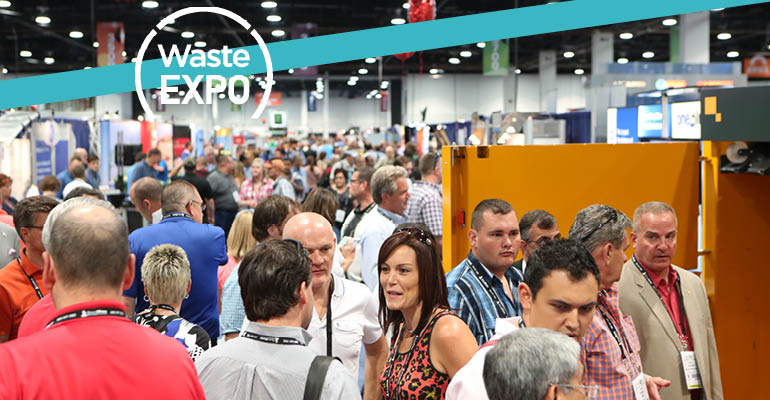Final Takeaways from WasteExpo 2017
Attendance at the conference’s education sessions was up 22 percent over 2016.

WasteExpo 2017, North America's largest solid waste, recycling and organics industry event, came to a close on Thursday in New Orleans.
Overall, more than 12,000 participants attended the show. More than 620 exhibitors featured booths at the show’s exhibit hall. And attendance at the conference’s education sessions was up 22 percent over 2016.
(For takeaways from the rest of the week, check out our wrap-ups from Day One, Day Two and Day Three.)
Here are some final takeaways from the event’s last two days:
Chaz Miller, director of policy and advocacy with the National Waste & Recycling Association (NWRA), sat down with Waste360 to discuss some of his current priorities.
One priority has been working with stakeholders and discussing the potentially negative impacts of two potential pieces of legislation in Connecticut and California. In Connecticut, a task force is in effect trying to increase packaging recycling. While in California, the state legislature has set a 75 percent goal for source reduction. “Setting a 75 percent goal is like saying the record for the mile should be 3 1/2 minutes,” Miller said.
There are details to be worked out in both cases. Miller is working to raise the the negative impacts to the recycling industry. For example, one piece of legislation being considered in California would establish product stewardship for beverage producers. California is already a bottle bill state. “No one knows what that means in a deposit situation,” Miller sayd. “We’re trying to find common ground and solutions.”
“One of the key issues people have to look at is, what are realistic recycling goals,” Miller said. “And a second is what is the purpose of a recycling goal? Is it the pursuit of tonnage or is it pursuit of less waste in the overall ecosystem and greenest environmental footprint? That's not necessary tons for the sake of tons.”
Another issue hanging over the sector is the lack of political appointments at the Environmental Protection Agency. Below the director level there are close to 200 positions that need to be filled by appointments, including some that require Senate hearings and confirmations. None of the Senate-confirmed positions been named yet. “What that means is if you're working on federal issues, you're kind of stymied,” Miller said. “People at the agency are not in place. Priorities are not yet determined. For key issues on the Hill that we are involved in, things are moving slowly.”
In one session, Dan Katt, corporate loss manager with Rumpke Waste & Recycling, provided a comprehensive look for how waste companies should best prepare for accidents and react once accidents have occurred.
Among pre-crash preparations, Katt pointed to determining pre-hire policies; conducting thorough trainings; having in place accountability and observation programs; and establishing relationships with local law enforcement.
Once an accident has occurred, conducting through site investigations is essential That includes gathering photos, interviewing key parties, creating incident diagrams and pulling any other information that is available. Katt emphasized the importance of collecting information as soon as possible, before the accident scene changes and when witness statements are fresh.
In cases where there are lawsuits, Katt said the most common outcome is a settlement in mediation rather than cases proceeding to trials.
Maite Quinn of Sims Municipal Recycling, Steve Alexander of the Association of Plastic Recyclers (APR), Ali Donahue of Keurig Green Mountain and Stephanie Baker of KW Plastics spoke about the limits to recycling in their session.
Donahue provided an overview of Keurig’s K-Cup pods recycling efforts and revealed that testing showed that an average of 90 percent of empty K-Cup pods make it to the container line. She also mentioned that optical sorters are key to the recovery of K-Cup pods and that by 2020, 100 percent of the company’s pods will be recyclable.
Baker highlighted the top three limits to recycling: access, technology and design. To have access, you need communities accepting Polypropylene (PP) in the bin and consistent education and communication. For technology, you need materials recovery facility (MRF) upgrades to optical sort for PP, molding investment around using post consumer recycling (PCR) and a focus on small part and black parts recovery. And for design, you need brands integrating PP PCR and packaging designed for recyclability. She also mentioned that to build demand, you need applications, value, brand owners, converters and certifications and compliance. And to grow supply, you need collection, sorting, value, communities, MRFs and investment.
Quinn stated that plastic bags are the most difficult material for MRFs to deal with. He also mentioned that other problems include film, polystyrene and extended polystyrene, bio-plastic, PVC fil, No.7-other, pouches, small items less than two inches, composite packaging, black plastics and bulky rigid plastics.
Alexander said that the APR primarily works on three areas: increasing supply, enhancing quality and communicating value. He also expressed that the mislabeling of products is a huge issue right now, and the APR deals with it every day.
Chris Coady of The Recycling Partnership, Ellen Martin of the Closed Loop Fund and Jim Cowhey of Organix Recycling shared the ins and outs of managing contamination.
Cowhey said that Organix Recycling is focusing on education, training and enforcing penalties to control contamination, such as plastic bags, glass, metal and garbage in compostable bags. He also shared that Organix Recycling controls access to containers by placing locks on them.
Coady highlighted five main contaminants: tanglers, film, bagged things, hazardous material and yuck. He also shared that education and operations need to work hand-in-hand to combat contamination and that more than 20 percent of contamination rates cost the system time and money and safety hazards for workers.
Martin explained the top five drivers of contamination: volume, operations, end-markets, transportation and financing.
Tarrah McCreary of Chartwells Compass and Rebecca Busse of Purdue University discussed food rescue and recovery in schools.
McCreary began the session by saying that 90 percent of us throw away food too soon, each of us tosses approximately 300 pounds of food waste every year and 20 percent of the food we each buy never gets eaten. She also explained that to achieve successful food rescue in schools, you need to engage the community early, empower students and exhibit results.
Busse said that the student-driven reasons for food waste include perceptions of school lunch, pickiness, snacks, à la carte and sack lunches. And that the policy-driven reasons for student food waste include time, recess, portions, options and palatability.
About the Authors
You May Also Like






